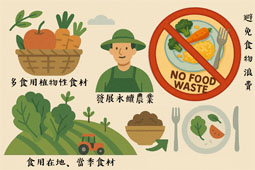
With the
pressures of climate change and resource scarcity, environmental sustainability
and food safety have become highly critical issues. In recent years, diet has
not only been seen as the foundation of health, but also closely tied to the
future of the Earth. How to safeguard human health and nutrition while
maintaining the balance of the natural environment, and promote a safe,
sustainable, and healthy food culture, has become an important challenge today.
What is Food
Safety?
Food safety
refers to ensuring that food is free from harmful substances throughout every
stage—from production, processing, transportation, storage to consumption—and
meets hygiene, quality, and nutritional standards. Food safety is particularly
crucial for vulnerable groups such as those with weakened immune systems, the
elderly, children, and individuals with chronic illnesses. The risks to food
safety are diverse and include: biological contamination (such as Salmonella,
E. coli, Listeria), chemical contamination (such as pesticide residues, heavy
metals, plasticizers), physical contamination (such as foreign objects),
improper use or unclear labeling of food additives, and incorrect processing
and preservation methods. In recent years, global food safety incidents have
occurred frequently, such as the melamine-tainted milk powder incident in
China, pathogenic E. coli-contaminated vegetables in Europe, and the
plasticizer and toxic starch incidents in Taiwan, all highlighting the
significant impact of food safety on public health.
Why is Food
Safety Closely Linked to Environmental Sustainability?
Many people
believe that food safety is primarily related to hygiene management and food
inspection, but in reality, it is closely interconnected with environmental
sustainability. If the food production process is not environmentally friendly,
it can exacerbate pollution problems, indirectly harming human health. For
example, modern agriculture relies heavily on large amounts of water, energy,
and chemical fertilizers and pesticides to increase yields. While these methods
may provide a large food supply in the short term, they can lead to soil
degradation and erosion, groundwater pollution, biodiversity loss, and the
accumulation of toxic substances in the food chain over time. Once the
environment is damaged, it becomes difficult to sustain a safe and healthy
source of food, which also affects the stability of food supplies for future
generations. What we consume is not just nutrition, but also a responsibility
toward the land.
How to
Practice Both Food Safety and Environmental Sustainability?
Building a
healthy and sustainable food system requires the joint effort of governments,
industries, and consumers. Here are several directions for implementation:
l Promote Local and
Seasonal Diets
Choosing local
and seasonal ingredients not only helps reduce the transportation distance and
refrigeration energy consumption of food, but also effectively lowers the risk
of spoilage and contamination during transportation. When the source of food is
more transparent, its quality is easier to manage. Additionally, supporting
local small farmers and agricultural processing industries strengthens the
community’s food self-sufficiency and reduces dependency on external supply
chains. This also enhances food resilience in extreme weather events or
pandemics, and promoting a "locally grown, locally consumed" diet is
one of the core strategies to achieve food sustainability.
l Develop Sustainable
Agriculture
Agriculture is
the foundation of human livelihood, but excessive intensification or reliance
on chemical resources can lead to soil depletion, water pollution, and
ecological imbalance. Therefore, promoting sustainable farming practices is key
to ensuring sustainable diets. Encouraging farmers to adopt organic farming,
crop rotation, green manure cultivation, biological pest control, and soil and
water conservation methods can reduce the use of chemical agents, restore soil
health, protect groundwater resources, and decrease the risks of pesticide
residues and heavy metal contamination in agricultural products.
l Reduce Meat Consumption
and Increase Plant-Based Diets
Excessive
consumption of red meat and processed meats is not only associated with chronic
diseases, but also imposes a heavy burden on the environment. According to data
from the United Nations, livestock farming accounts for more than 15% of global
greenhouse gas emissions, and requires vast amounts of water and food to raise
animals, indirectly contributing to deforestation and land degradation.
Therefore, advocating for a "less meat, more vegetables" or
"plant-based" diet is not only a health promotion strategy but also
an action to reduce carbon footprints and protect the environment.
l Reduce Food Waste
Every year,
around one-third of the food produced globally is wasted. From losses at the
production stage, to specification rejections during processing, to food being
discarded at retail or in households due to over-purchasing or improper
storage, every stage is worth examining and improving. Practicing "food
saving" can start with daily habits, such as planning shopping lists,
creatively using leftovers to prepare new dishes, freezing cooked or
near-expiration foods for later use, which all help reduce food waste and
alleviate the burden of waste treatment and carbon emissions.
l Raise Consumer Awareness
of Food Safety and Sustainability
Changes in
dietary behaviors ultimately rely on consumer awareness and choices. By
promoting transparency in food labeling, advocating for sustainable diets, and
implementing nutrition education programs in schools and healthcare
institutions, we can enhance the public’s ability to recognize safe food and
eco-friendly choices, fostering a positive consumption culture.
Eating
Healthily, and Eating Sustainably
Food safety and
environmental sustainability may seem like two parallel issues, but they are,
in fact, intricately intertwined. Only by building a food system that is
friendly to the land, responsible to the climate, and harmless to the human
body can we ensure that everyone has access to a healthy, safe, and lasting
food source. We should start with ourselves, change our choices, and take
action through our diets to protect the health of the Earth and future
generations.
